You get rid of birds in your attic by identifying and removing them – preferably with professional intervention. And you may be surprised to know that bird nesting is a common problem for homeowners in New Jersey. Once outdoor temperatures begin to warm up with the change from winter to spring, starlings and sparrows begin building nests to lay eggs.
European starlings and house sparrows are social birds that prefer to live in flocks within natural habitats and human made spaces like attics. If you’ve ever experienced a bird infestation, you know how serious and frustrating it can be. Excessive droppings, physical damage, and noise only increase throughout the season if the problem isn’t taken care of.
Did you know birds will return to the same spots year after year if they have access? If there’s nothing to stop them from nesting, why would they go elsewhere?
How Do You Know If You Have Birds in Your Attic?
Once birds get indoors, they aren’t especially stealthy. You’ll know if you have them in your attic when you hear excessive flapping, banging, or scratching noises in your attic. If you see the birds, they may be starlings and sparrows.
They are most active in the early morning and evening, but that doesn’t mean you won’t hear them at other times of the day. Birds poop everywhere, which is the first telltale sign that birds are roosting in your attic. When you enter your attic, you’ll be hit with an unmistakable stench which is a dead giveaway. Bird droppings accumulate very quickly, mainly because they live in large flocks.
Birds also like to nest within:
- Soffits
- Gable vents
- Broken vent covers (for exhaust fans)
- Stove vents
- Bathroom vents
- Dryer vents
- Exposed gutters
- Light fixtures (by entranceways)
European Starlings
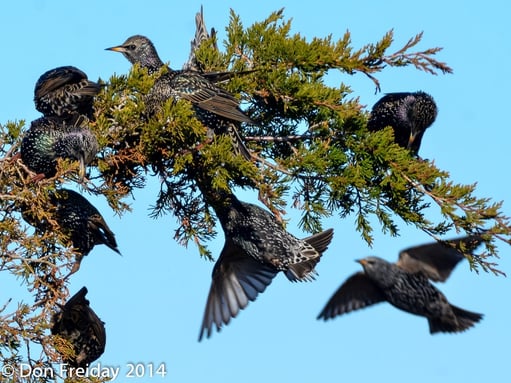
Photo Credit: Don Freiday
European Starlings are arguably the most common nuisance birds in New Jersey. The massive groups of noisy black birds on your lawn are probably of this kind. We’ve all encountered them outdoors, but they are a significant problem when they nest in attics.
European Starlings can be identified by:
- Black feathers with a greenish-blue iridescence that’s covered in white spots.
- A pointed yellow bill.
- Their small size – eight to ten inches long with a 12-16 inch wingspan.
House Sparrows
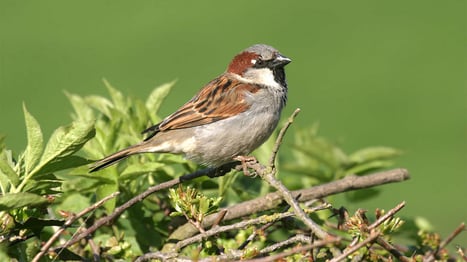
Photo Credit: Don Freiday
These non-native birds are abundant in New Jersey and Eastern Pennsylvania, as well as across the entire country. Much like European starlings, house sparrows gather in large groups and feed on lawns and around your property. They also prefer nesting in light fixtures, gutters, and attics.
House sparrows are very small birds with unique coloring – you can identify them by looking for the following:
- Females have black and brown striped backs with a grayish-brown body.
- Males are very similar, with the exception of darker reddish brown coloring on their heads and dark brown mixed in with black stripes on their backs.
What Are the Health Risks of Birds Nesting in Your Attic?
Birds are very messy animals. Their poop can quickly accumulate, causing a health hazard. Bird droppings can transmit various pathogens, parasites, and bacteria, with the risk increasing as the bird problem goes unaddressed.
If you’re waiting until the birds leave on their own, you’re out of luck. Some types of local birds come back to the same place year after year if they can. When they find an insulated, dry space that protects their nests from predators and rain, there is no reason for them to leave.
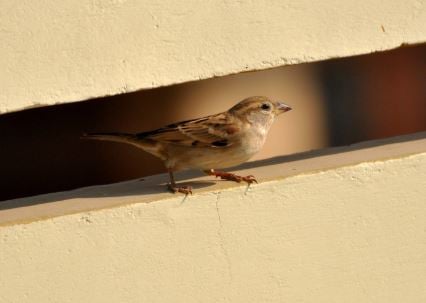
Birds will make their nests out of both natural and manufactured materials. On a quest for nesting materials, birds can tear through wiring in your attic, which is an immediate fire hazard. They can also rip up attic insulation and paper stored in your attic. Fallen hair and string are also favorite items for bird nesting. In addition to destroying your personal items, birds also bring outdoor nesting materials indoors. That means leaves, feathers, grass, and other vegetation will be stockpiled around your attic.
Top Bird Prevention & Removal Tips for Homeowners
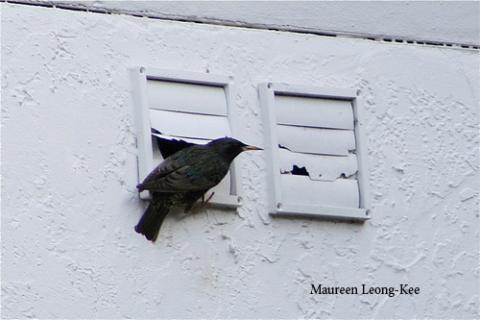
Photo Credit: U.S. Department of Energy
As a homeowner, you’re probably wondering what you can do on your own to prevent and get rid of birds in your attic. It’s a good idea to do this before bird nesting season begins to prevent the problem before it happens.
The most effective way to handle bird infestations is to make sure that all potential entry points are sealed. We also recommend following these tips to keep birds out:
- Inspect your attic for broken or torn vents, small holes that lead outdoors, or any other possible entry points. By using a flashlight, you can more easily find openings that allow you to see outside.
- Walk around the exterior of your home and look for holes around gutter lines, up under soffits, and additional torn or old vents.
- Avoid having any bird feeders or birdbaths. Bird feeders and birdbaths are troublesome for several reasons. Not only will it encourage birds to spend extended time on your property, but it can also attract other undesirable critters.
- Don’t put out any birdseed. Mice, rats, squirrels, and other local wildlife are drawn to fallen bird seed in your yard. Birds are messy eaters, leaving a large amount of their meal on the ground.
Squirrels are another notorious pest that loves bird feeders. You’ve probably seen bird feeders in your local retailer or garden center that have springs built in to avoid squirrels. While this may provide some relief, it’s never guaranteed that squirrels won’t be crafty enough to snag a free meal.
You also need to be careful if you find eggs or chicks in your attic. Sealing them inside prevents their mother from bringing in food, which will result in death. They can also be forced into additional parts of your home once they are able to move on their own as they search for a way to leave the house.
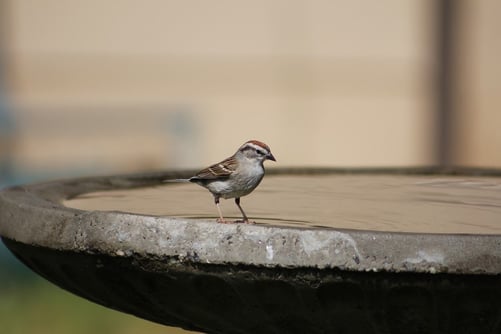
If you find live birds in your attic, call Cooper Pest Solutions for professional removal and sealing services.
How Much Does it Cost to Remove Birds From an Attic?
The cost of Cooper’s bird exclusion service is based on the area of your home that our exclusion expert needs to seal and the scope of the work needed to fully exclude the birds. If the bird problem is severe, pricing is subject to vary. This is a permanent solution with no ongoing maintenance needed.
Watch the video below to learn about Cooper’s bird exclusion service from exclusion expert, Joel:
Cooper Pest Solutions Can Get Rid of the Birds in Your Attic
If you have birds in your attic, we’re here to help! Cooper is the humane and permanent solution to bird nesting and activity in your attic. Instead of poisons, chemicals, or euthanasia, our strategy involves humane bird removal and sealing. Once the birds have left, our exclusion experts will seal your home against re-entry. Our tactics include:
- Aluminum flashing installation to block entry points
- Hardware cloth to prevent reentry
- Expandable foam to thoroughly seal gaps
- Bird spikes to prevent nesting and additional activity

Pictured Above: Entry point is permanently closed off with metal flashing where birds were getting into a client’s attic.

